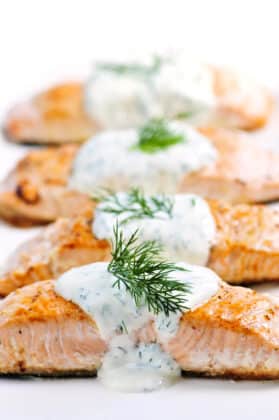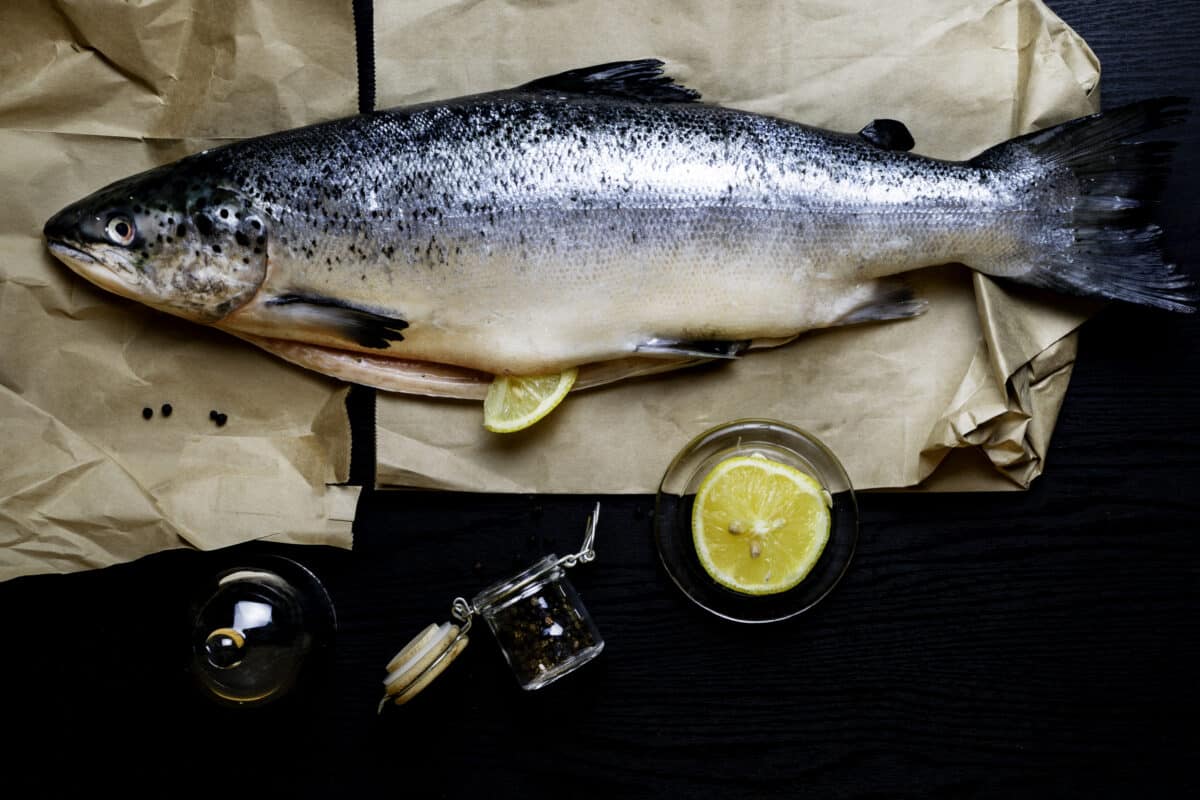I serve the dish on many joyous occasions [but] I always think of this dish as “Funeral Salmon.” It’s not a sad association. It represents care, and comfort, and love.
A Lesson from a Cantor’s Wife
I was having a conversation with an older woman whose husband was a Jewish cantor, when she had to stop to take a call. It was not-unexpected news that a member of their congregation had died. When the call ended she said to me, somewhat apologetically, “I have to go take a salmon out of the freezer.” As I followed her to the kitchen she explained.
A cantor is a member of the clergy who leads the congregation during services through chanting and singing. In a Jewish community it is an important and honored leadership position, carrying with it social obligations that reach outside the temple walls. Like the spouse of a rabbi – or indeed, any important figure – the spouse of a cantor is a fixture and role model in the community.
When there was a death in her congregation, my friend was one of the first to know, and, out of kindness and propriety, had to be among the first to respond. A whole cooked salmon, always kept ready in her freezer, was plattered, garnished, and quickly delivered to the congregant’s family – defrosted by the time the first serving was plated.
Sorrow and Cake
In the first shock of a loss the bereaved don’t want to eat. Grief has no appetite. Who could be hungry when the heart is hurting? But the giving and accepting of food is an exchange of messages: “I care.” and “I know you care.” And, no matter how much we may resist being comforted, the gestures of a fragrant cake, home-made soup, a plate of sandwiches, let us know that others are interested in our well-being. “Eat, just a little. I brought you some food.”
A Fish for a Multitude
I watched my friend prepare the frozen fish for the bereaved family. It was a whole salmon minus the head that had been oiled, tightly wrapped in foil, put on a baking sheet, and roasted until opaque throughout. It was then cooled and put in the freezer.
Now my friend carefully unwrapped the foil and pulled it off the fish. The skin of the fish stuck to the foil and pulled off, revealing a naked pink log that she placed on a long platter lined with lettuce leaves. Wafer-thin slices of lemon and lime were arranged around the edge of the fish. Another line of sliced fruit decorated the top, interspersed with sprigs of dill and curls of lemon zest. She covered the platter tightly with plastic wrap and set off to deliver her condolences and her salmon. The fish would be served cold, enough to feed a multitude of mourners.

Salmon for a Party
I am fortunate in rarely having to cook for a memorial gathering. But I do often cook for a crowd. There are parties for birthdays and graduations and, while my kids were still in school, we had an annual Last-Day-of-School garden party for about eighty people. Baked salmon is ideal party food, especially when beautifully plated and accompanied by cold cucumber-dill sauce. The salmon can be baked the day before a party and
chilled overnight, no freezing needed. This dish is just as good when made with steelhead trout, which has a color, flavor, and flakiness similar to salmon. I choose according to the size of fish available and the price.
There is a particular way to serve the dish, and I always cut the first piece and leave it as a demonstration. A sharp knife and decorative spatula are needed. First cut down only as far as the center bone, then slide the spatula under the fish and lift it onto the serving plate. Continue across the fish until the entire spine is exposed. Then lift the vertebrae and bones as one piece, leaving a new layer of pink fish to be served.
In spite of the many times I serve the dish on joyous occasions, I always think of this dish as “Funeral Salmon.” It’s not a sad association. It represents care, and comfort, and love. Can you taste love? Sure. Love can taste warm or cool, sweet or spicy, even sharp or bitter. Sometimes it tastes like salmon.
Funeral Salmon with Cucumber-Dill Sauce: The Recipe
Purchase a whole scaled and cleaned salmon or steelhead trout (also known as steelhead salmon or salmon trout) of any size. The fish may be roasted with or without the head, but I prefer to have the head and tail removed. You may be tempted to stuff the fish with lemon or herbs before roasting it. I advise against that, as when the fish is served it will look messy and unappetizing once the top layer of fish is removed. Nothing more than lemon wedges and chilled cucumber-dill sauce will be needed to enhance the flavor of the fish.

Preheat an oven to 204°C (400᷾°F). Rub the fish with vegetable oil, and wrap well in aluminum foil so that any juices released will not leak out. Place on a baking sheet and roast until the internal temperature at the thickest part of the fish is 48°C (120°F). Leave the fish wrapped (it will continue to cook a bit) and allow it to cool. It may be refrigerated overnight or frozen.
To serve, remove the foil, which will pull off the skin. Arrange the fish on a platter and decorate and garnish as desired. Serve with lemon wedges and Cucumber-Dill Sauce.
To make Cucumber-Dill Sauce, peel two large seedless cucumbers, and finely chop or grate them in a food processor. Transfer them to a heatproof bowl and cover with boiling water. After ten seconds, drain in a fine-mesh colander and rinse with cold water. Squeeze out excess water and return to the bowl. Add 355 ml (1 ½ cups) sour cream, 60 ml (¼ cup) cider vinegar, 10 ml (2 teaspoons) sugar, and 71 ml (⅓ cup) minced fresh dill. Season with salt and white pepper to taste. ![]()
